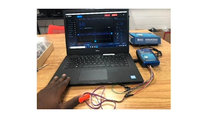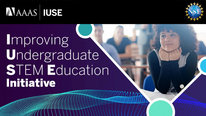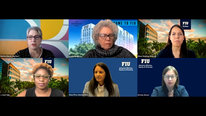- Anya Goodman
- https://chemistry.calpoly.edu/content/faculty/goodman_anya
- Professor
- Sustaining and Growing a Dispersed Community of Practice that Engages Undergraduates in Course-Based Genomics Research
- https://thegep.org/
- Cal Poly San Luis Obispo
- Rivka Glaser
- Associate Professor, Director of Honors Program
- Sustaining and Growing a Dispersed Community of Practice that Engages Undergraduates in Course-Based Genomics Research
- https://thegep.org/
- Stevenson University
- Laura Reed
- http://flygxe.ua.edu/
- Associate Professor
- Sustaining and Growing a Dispersed Community of Practice that Engages Undergraduates in Course-Based Genomics Research
- https://thegep.org/
- University of Alabama Tuscaloosa, Genomics Education Partnership
- Katie Sandlin
- https://www.linkedin.com/in/kmsandlin
- Curriculum, Recruitment, & Training Specialist
- Sustaining and Growing a Dispersed Community of Practice that Engages Undergraduates in Course-Based Genomics Research
- https://thegep.org/
- Genomics Education Partnership, University of Alabama Tuscaloosa
- Marisol Santisteban
- Professor
- Sustaining and Growing a Dispersed Community of Practice that Engages Undergraduates in Course-Based Genomics Research
- https://thegep.org/
- University of North Carolina Pembroke
- Alexa Sawa
- Associate Professor, Biology
- Sustaining and Growing a Dispersed Community of Practice that Engages Undergraduates in Course-Based Genomics Research
- https://thegep.org/
- College of the Desert, Genomics Education Partnership
Public Discussion
Continue the discussion of this presentation on the Multiplex. Go to Multiplex












Katie Sandlin
Curriculum, Recruitment, & Training Specialist
Thank you for watching our video on how the Genomics Education Partnership (thegep.org) adapted to the rapid transition to remote learning brought on by the COVID-19 pandemic!
The pandemic left faculty scrambling to provide students with an online research experience. GEP was uniquely prepared to transition the core research component of the course to an online setting almost seamlessly because the research being done – the genomics – is done online.
The pandemic has further exposed the power of the GEP and its ability to reach all students on a grand scale. Now, the potential for wide adoption during non-pandemic times is even more clear. The research experience should not be limited to those who have access to a lab. When the world shifted online during the pandemic, GEP proved that research can still go on. We are more confident than ever that nationwide, all students can have access to a research experience and not just during a pandemic but always.
The GEP is happy to invite interested current and future faculty to contact us and join our partnership (thegep.org/contact)!
We are most interested in discussing how faculty adapted to, and strategies for keeping students engaged during, fully virtual scientific instruction. Our team is looking forward to answering questions about our work, and we'd also love to hear:
Follow GEP on Twitter: @GEP_CURE
Cristo Leon
Cristo Leon
Dear Katie,
This is amazing work. Do you have any best practices for CoPs we are working with a really similar issue but in K-12 hands-on STEM
Katie Sandlin
Curriculum, Recruitment, & Training Specialist
That's a great question; unfortunately, we haven't been able to analyze our community data yet, but we do plan to do that at the end of our grant period and will certainly publish our findings!
Patricia Marsteller
Professor of Practice Emeritus
This is fascinating. I am already familiar with the project, but am so happy to see how you all adapted to the pandemic. I hope there will be publications about the adaptations for faculty and students.
I am interested in whether any students or faculty had access issues, because we saw that many students did not have appropriate computer or internet access, especially those who were in other countries.
I'd also like to hear others experiences about barriers and adaptations.
Love your questions above!
Katie Sandlin
Curriculum, Recruitment, & Training Specialist
Hi Dr. Marsteller!
We have multiple groups trying to work on publishing what we've learned throughout the pandemic; however, as with everyone else, things have tended to move a bit slower with all of the added complexities the pandemic brought to academia so it might be a bit before they are published.
I strongly feel one of the key takeaways for us has been the creation of our virtual peer mentors/teaching assistants (TAs). With such a large partnership (200+ faculty members at 170+ institutions and growing), it is not financially feasible to support, nor sustainable to train, such a large number of TAs every year for all of our members. Plus, in-person TAs at individual institutions typically only hold office hours for a few hours per week which makes it difficult for many students to access help. We have virtual TAs available 7 days a week (~48 hours/week in Spring 2021). We’ve had wonderful feedback from many of our students about how helpful the virtual TAs have been. While virtual TAs arose due to the pandemic, we definitely plan to continue having them post-pandemic.
In non-pandemic times, GEP is certainly a democratizer in that costly infrastructure isn’t needed to do our research projects so no matter how small or underfunded an institution may be, their students are still able to gain research experience with a computer and internet access. However, with COVID-19, many campuses closed their computer labs so that did pose an additional access issue for students that didn’t own personal computers. Our members worked with their students and institutions to try to resolve those issues whenever possible (e.g., loaning laptops from campus libraries).
Thank you for engaging with us,
Katie
Rita Hagevik
Yes CURES are great and I wish there were MORE of them for all units in Biology actually and that we did more of this in all of our classes at UNCP!
Rivka Glaser
Associate Professor, Director of Honors Program
Thank you for watching our video!
Jay Labov
Senior Advisor for Education and Communication (Retired)
Thank you for posting this video! I have known about GEP almost since its inception through my work at the National Academies with Sarah Elgin, one of GEP's founders and organizers. I especially like the fact that GEP focuses on addressing issues related to CUREs systemically, through both students and their faculty mentors.
Patricia Marsteller, a co-facilitator asked about access during the pandemic even though all of the work done through GEP is virtual. In listening through multiple sources about challenges faced by students trying to work virtually during the pandemic, two primary issues emerged: 2) lack of access to the internet when working off-campus, and 2) problems of being able to read and understand materials from their cell phones when that material was designed to be displayed on larger screens that the students didn't own.
Has GEP adopted its materials for use on small screen cell phones? I also wonder whether GEP has thought about partnering with telecomm companies to provide nodes for internet access to students without that access. Several of them have touted their efforts during the pandemic to bring such access to K-12 students. Watching what opportunities might emerge from President Biden's infrastructure bill related to broadband access might also provide some powerful collaborations in the future should the bill become law.
Thank you again for letting this community know about GEP!
Judith Dilts
Patricia Marsteller
Professor of Practice Emeritus
https://serc.carleton.edu/curenet/index.html
for lots of cure's I also have a number of papers on cure's I can share.
Thanks Jay for extending my comment. I do think access is really important. Working on small screen laptops is hard enough, but cellphones..Yikes!
Anya Goodman
Professor
Dear Jay and Patricia, we did worry about access to technology and did a survey of our faculty last spring. We considered leveraging our GEP community resources to create loaner laptop sets, but it did not turn out to be necessary. It appeared that most institutions were creating local campus solutions to the tech access problem (e.g. loaner technology from campus). In a way, the pandemic forced campuses to deal with technology access since it became a problem for student learning in all courses, not just tech-heavy courses in genomics or biology. So over the past year, we focused our GEP community efforts on broadening access to research experiences and genomics by increasing student support through our virtual TAs (available 7-days a week for 6-8 hours a day), improving curriculum, and supporting teachers (mentored online professional development, broadening recruitment, building community).
We are really working on expanding our network to welcome more community colleges and MSIs! I hope we can engage in conversation here with other professional development communities that are successful in this endeavor! and also hope to hear from individual faculty who are at CCs and MSIs - how can we better recruit and support faculty so we can serve a more diverse student population?
Judith Dilts
Retired Associate Dean, College of Science and Mathematics
GEP is definitely a natural for COVID times. I have wondered this past year what of the changes we were forced to make would survive because of the good they could do. I can see how the expanded work of GEP will survive! Along the line of Jay's question, I wondered about the availability of internet access via institutions and at home. Were there students who couldn't be involved because access to internet was unavailable? Were there hotspot solutions? Thanks! This is a great project.
Alexa Sawa
Associate Professor, Biology
Hi Judith,
I think what happened at my California community college was similar to the experience of other GEP faculty. During COVID because EVERYTHING was online, my college set up programs to get the students hot spots and laptops. Since participating in the GEP did not require any more technology that participating in the rest of our online course, the students were OK. I am sure we lost some who just didn't register for a fully online class, but we also gained a few from outside our local area. The GEP, of course, also has the advantage that it is free of students and faculty. It is nice that we do not have to pay in the way some online lab simulations require.
What the students needed more than technology was instructional support. Learning online can feel very lonely. One of my favorite things about doing GEP in person is that I use past students as peer tutors. That part was much harder online. What the GEP did to address the problem was hire online TAs. Our GEP TAs are available 7 days a week for many hours per day to help students who are trying to annotate at home.
The other nice thing about the TAs is that some of them are former community college students. Now they get to help students from across the country from a wide range of institutions and experience levels. This is great for their confidence, broadens their horizons, and helps them feel connected to a scientific community.
Judith Dilts
Stan Yoshinobu
Thank you for sharing your info about the GEP project! Appreciate especially the comment by the student saying she joined a scientific community! In a nutshell that's what it's about.
Marisol Santisteban
Professor
Thanks for watching our video Stan!
You are absolutely right: that's is what it's about! We actually learned that students find really appealing and motivating that they are part of a larger project. We have a project claim/submission system for all three scientific projects, and students from different institutions may claim the same project. We want to have at least two institutions claiming a project. Then, once the projects are submitted, they are reconciled. Students are aware of the process and thrilled that their project will become part of a larger common effort, and that their annotations will be submitted to publicly available databases.
Also, the more times we remind them of that and the fact that they are doing genuine research, the more fulfilling the experience is for them!
Cheers!
Rita Hagevik
There need to be more programs like this to assist faculty in integrating CURES into undergraduate education for students for sure!
Rebecca Roberts
Congratulations on a great project. I’m curious how the support by the mentors was organized.
Anya Goodman
Professor
Hi Rebecca, thank you! We have two types of mentors: virtual TAs serve to support students and faculty mentors for fellow faculty. Virtual TAs are recruited among students who completed research projects/CURE courses - they are paid, get extra training, and work as a geographically distributed team. In preparation for this presentation, we got amazing submissions from our virtual TAs about their experience - but we could not fit them into this 3-min video for STEM For ALL; this summer, we'll edit/put together a TA video and post it to our GEP website and youtube channel. Faculty mentors for other faculty are volunteers. In our efforts to expand access to training and support for faculty across the country, we started doing virtual training in 2019; when the pandemic hit in spring of 2020 - we already had some experience with training faculty virtually, so we were ready to expand and offer support for more faculty during sudden pivot to online instruction. One of the ideas that came out of original virtual training and from the rapid growth of our community was the need to connect individual faculty members with each other to offer easy access to experienced colleagues. We matched volunteer mentors with newly trained faculty based on similar instructional implementation and if possible - based on geography. In addition to the virtual community, we have a network of regional nodes that during non-pandemic times hold in-person activities. The pandemic did disrupt those plans, but we hope in-person local events will resume soon- that will facilitate communication and connections between GEP members, including newly trained faculty and their volunteer mentors.